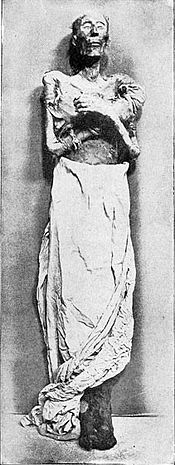Ramesses II
Ramesses II (also known as Ramesses the Great and alternatively transcribed as Ramses and Rameses) was an Egyptian pharaoh of the nineteenth dynasty. He lived from ca. 1302 BC to 1213 BC and reigned from either 1279 BC to 1213 BC or 1290 BC to 1224 BC. He ruled for a total of 66 years and 2 months, becoming pharaoh in his early 20s. He was once said to have lived to be 99 years old, but it is more likely that he died in his ninetieth year. Ancient Greek writers (such as Herodotus) ascribed his accomplishments to the semi-mythical Sesostris. He is widely believed to have been the Pharaoh of the Exodus.
Life
Ramesses II was the third king of the 19th dynasty, and the son of Seti I and his Queen Tuya. The most memorable of Ramesses' wives was Nefertari. Others among his wives were Isisnofret and Maathorneferure, Princess of Hatti. The writer Terence Gray stated in 1923 that Ramesses II had as many as 200 sons and 200 daughters; more recent scholars, however, believe his offspring, while numerous, were far fewer, somewhere around 90. His children include Bintanath and Meritamen (princesses and their father's wives), Setnakht (Sethnakhte), the Pharaoh Merneptah (who succeeded him), and prince Khaemweset.

Ramesses led several expeditions north into the lands east of the Mediterranean (the location of the modern Israel, Palestine, Lebanon and Syria). At the Battle of Kadesh in the fourth year of his reign (1286 BC), Egyptian forces under Ramesses engaged the forces of Muwatallis, king of the Hittites. Over the following years, neither power could effectively defeat the other. Consequently, in the twenty-first year of his reign (1258 BC), Ramesses concluded an agreement with Hattusilis III, which is the earliest known surviving peace treaty in world history.
| ||||||||||||||||||||||||||||
| Ramesses II in hieroglyphs | ||||||||||||||||||||||||||||
|---|---|---|---|---|---|---|---|---|---|---|---|---|---|---|---|---|---|---|---|---|---|---|---|---|---|---|---|---|
| Era: New Kingdom (1550–1069 BC) | ||||||||||||||||||||||||||||
Ramesses also campaigned south of the first cataract into Nubia. He constructed many impressive monuments, including the renowned archeological complex of Abu Simbel, and more statues of him exist than of any other Egyptian pharaoh: Ramesses indeed provided the artisans who lived in Deir el Medina with plenty of work.
At least as early as Eusebius of Caesarea, he was identified with the pharaoh of whom the Biblical figure Moses is popularly believed to have demanded that his people be released from slavery.
He was buried in the Valley of the Kings, in KV7, but his mummy was later moved to the mummy cache at Deir el-Bahri, where it was found in 1881 and placed in the Egyptian Museum in Cairo five years later, where it is still exhibited with pride by the Egyptian people. His successor was his son Merneptah.
As with most pharaohs, Ramesses had a number of names. The two most important, his praenomen (regnal name) and nomen (birth name) are shown in Egyptian hieroglyphs above to the right. These names are transliterated as wsr-m3‘t-r‘–stp-n-r‘ r‘-ms-sw–mry-ỉ-mn, which is usually realised as something like Usermaatra-setepenra Ramessu-meryamen. They can be translated as "Powerful one of Maat and Ra, chosen of Ra, Ra bore him, beloved of Amun".
See also
Further reading
- James, T. G. H. 2000. Ramesses II. New York: Friedman/Fairfax Publishers. A large-format volume by the former Keeper of Egyptian Antiquities at the British Museum, filled with colour illustrations of buildings, art, etc. related to Ramesses II
- Kitchen, Kenneth Anderson. 1982. Pharaoh Triumphant: The Life and Times of Ramesses II, King of Egypt. Monumenta Hannah Sheen Dedicata 2. Mississauga: Benben Publications. ISBN 0856682152. This is an English language treatment of the life of Ramesses II at a semi-popular level
- Kitchen, Kenneth Anderson. 1996. Ramesside Inscriptions Translated and Annotated: Translations. Volume 2: Ramesses II; Royal Inscriptions. Oxford: Blackwell Publishers. ISBN 0631184279. Translations and (in the 1999 volume below) notes on all contemporary royal inscriptions naming the king.
- Kitchen, Kenneth Anderson. 1999. Ramesside Inscriptions Translated and Annotated: Notes and Comments. Volume 2: Ramesses II; Royal Inscriptions. Oxford: Blackwell Publishers
Fiction
The life of Ramesses II has also inspired a large number of historical novels, including the five volume series, Ramsès, by the French writer Christian Jacq. Translated editions are available for non-French readers.
External links
- TourEgypt.net site devoted to the Pharaohs, with many pages on Ramesses and his family
- A short study of his prosperous reign (on GeoCities; JavaScript pop-up ad)
